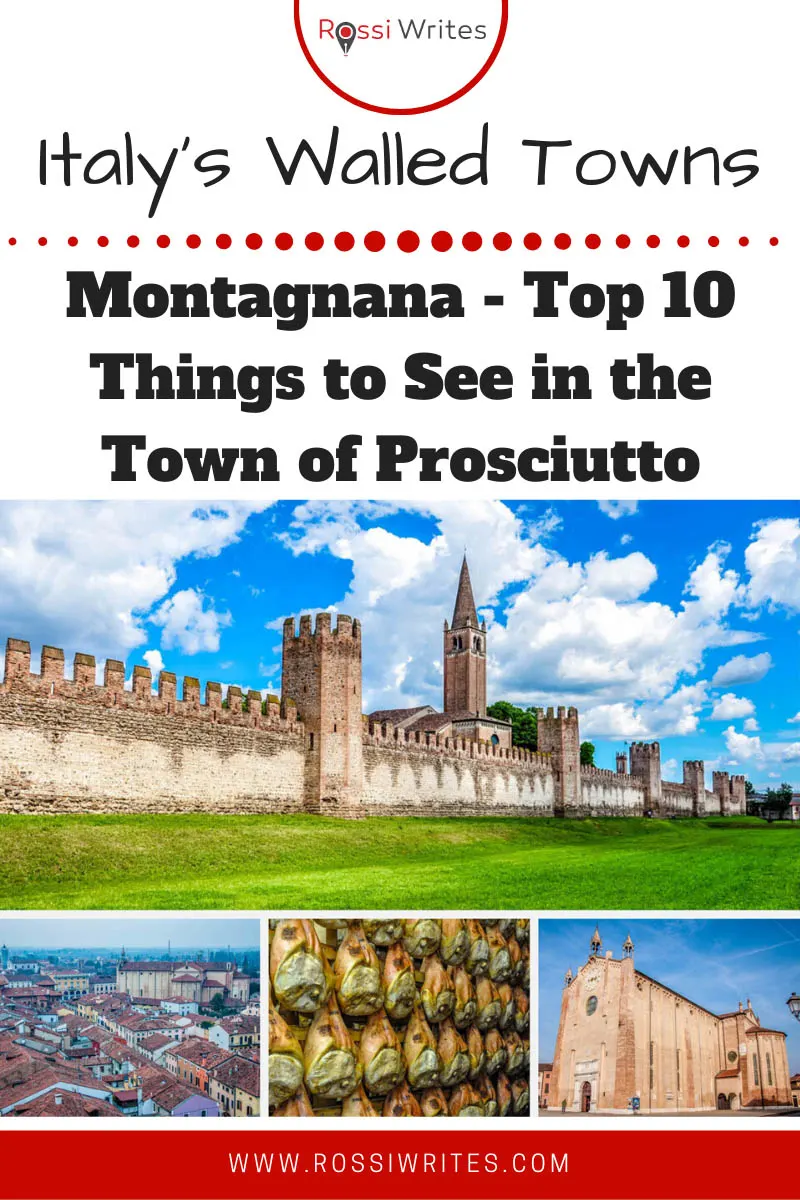Montagnana – a medieval fortified town in the Northern Italian region of the Veneto – is officially recognised as one of Italy’s most beautiful borghi.
Surrounded by a mighty defensive wall and with a dramatic Duomo at its heart where frescoes by Giorgione and an altar painting by Veronese are preserved, Montagnana is an excellent choice for a day trip dedicated to art, history, and incredibly good food.
With a history that spans thousands of years and a particularly interesting medieval period, Montagnana experienced many transformations throughout the centuries. In Roman times, the town was a military fortified castrum and served as an official postal station. Then, during the Middle Ages, Montagnana became the battleground of the area’s powerful feudal dynasties.
To this day a large defensive wall circumnavigating the whole town bears witness to the battles that were waged in defense of and against Montagnana.
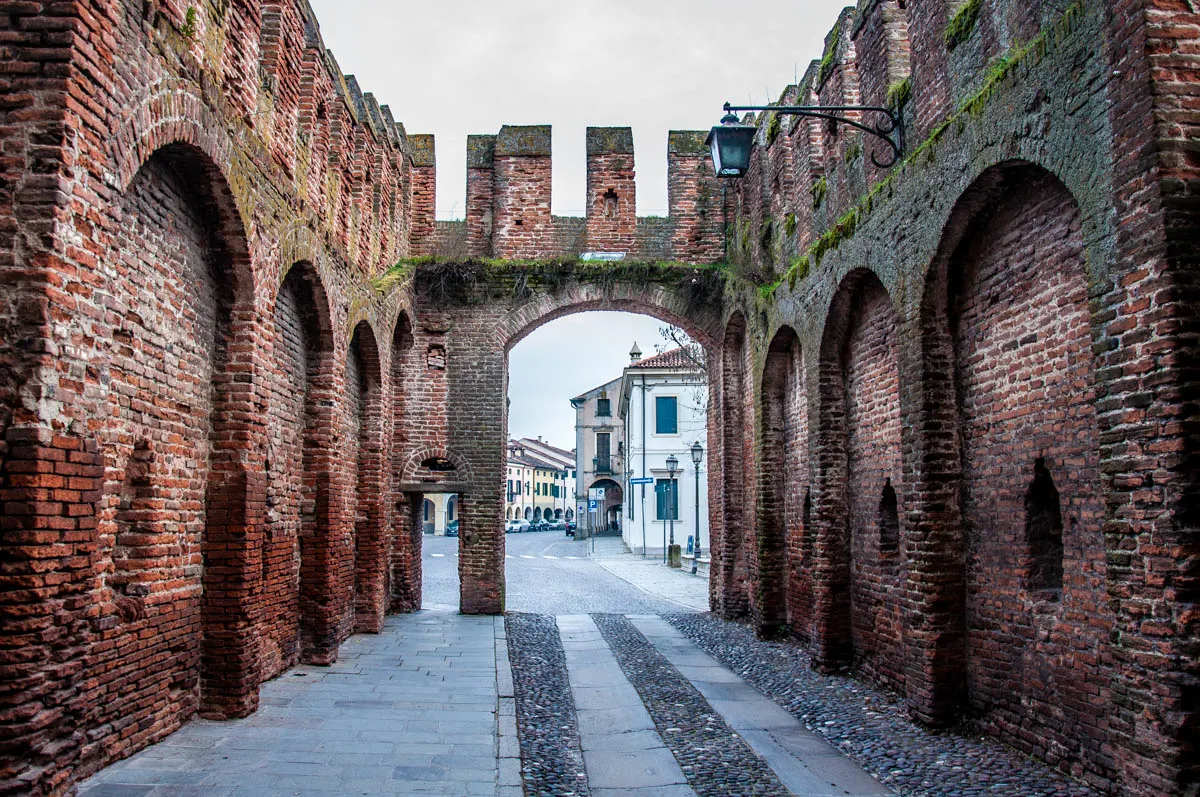
In 1405, the town was annexed to the Republic of Venice and flourished economically, culturally, and artistically. A testament to it are the many Late Gothic and Renaissance palaces dotted around Montagnana’s historic centre and the priceless works of art in the town’s Duomo and Civic Museum.
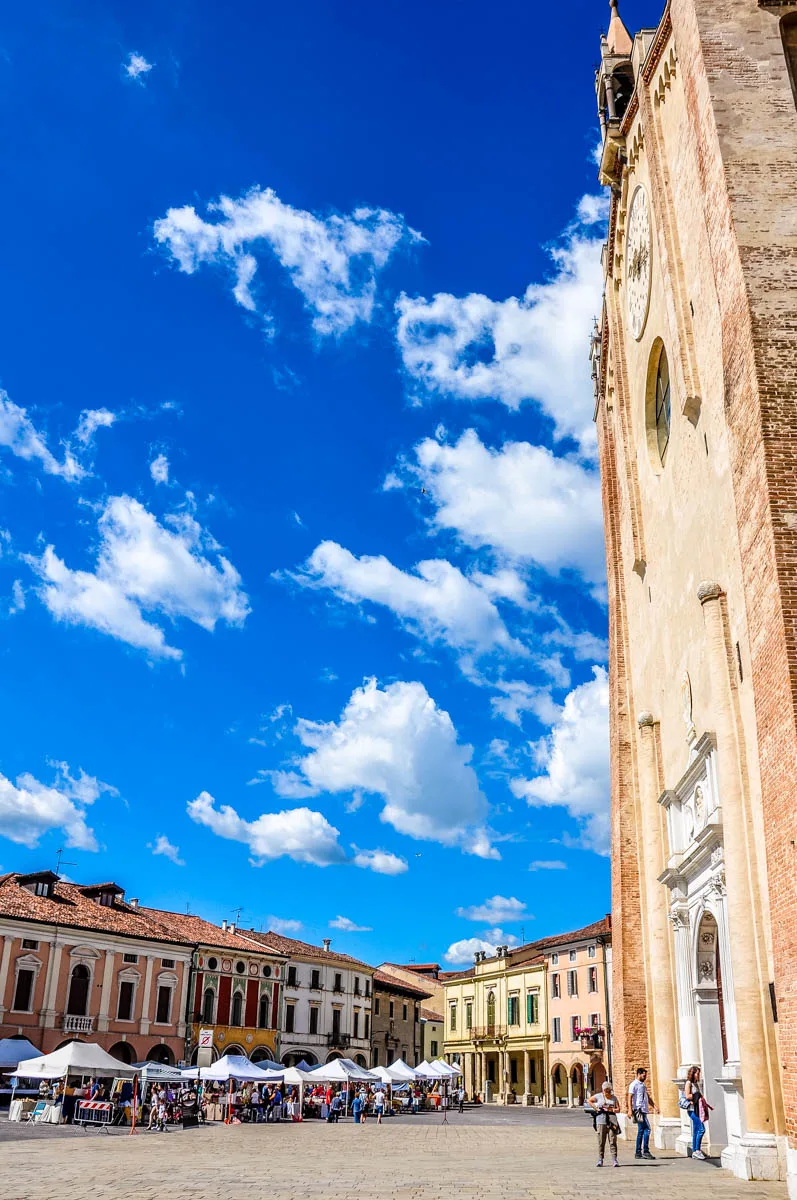
In addition to its artistic and historic significance, Montagnana is also the leading centre of production of one of the best dry-cured hams in all of Italy. Known as Prosciutto Veneto Berico-Euganeo DOP and enjoying a Protected Designation of Origin status, the prosciutto of Montagnana is a source of local pride that can be best felt and enjoyed during the prosciutto festival held here in spring each year.
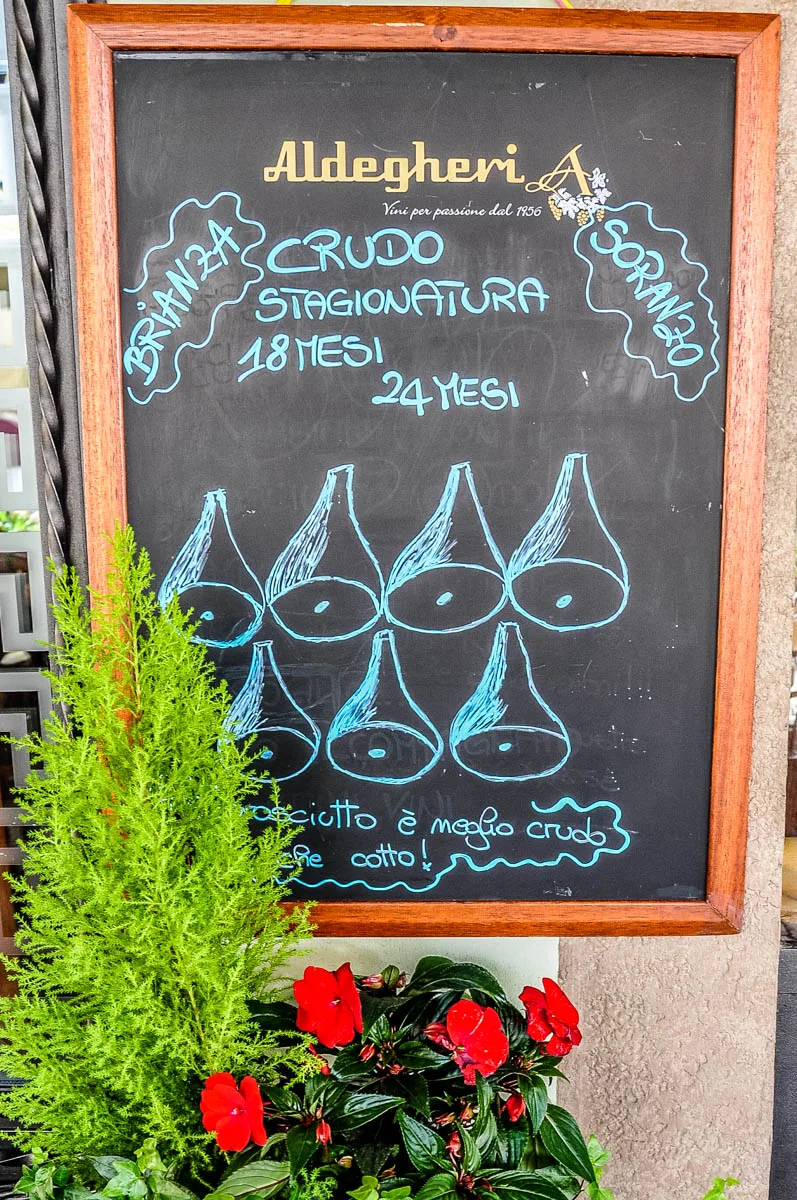
Add to this the many events regularly organised here and the sheer exuberance of beauty that Montagnana is known for and this little town in the Venetian plains easily becomes a must-see place.
So, make sure that you put it on your bucket list for the Northern Italian region of the Veneto and then tick it off with flourish once you have spent a day (or more) taking in all that Montagnana has to offer.
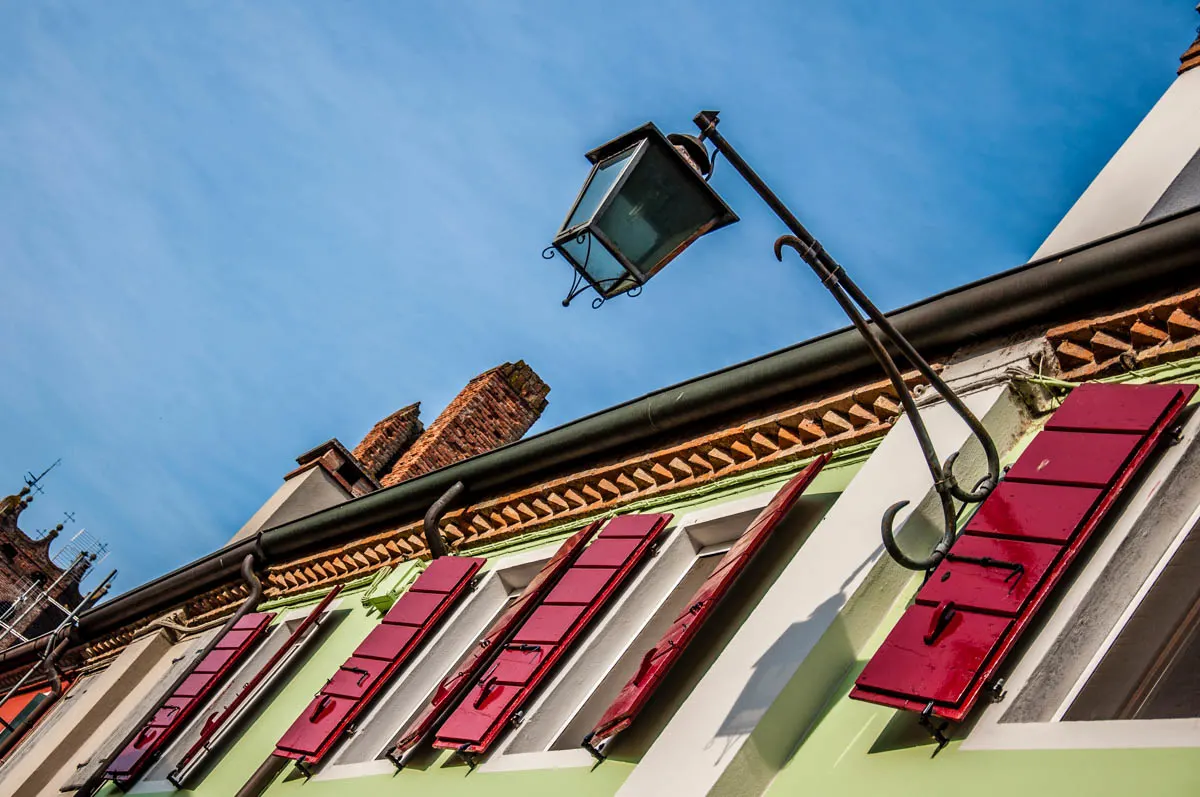
To make your planning easy and smooth here is a nice and tidy list with the most important and picturesque things to see and do in Montagnana, Italy. They are all based on the many hours I have happily spent exploring this lovely walled town by delving deep into its history and every plate of local prosciutto that has come my way.
At the end of this blog post, I have also included a short historical overview of the town of Montagnana through the centuries and some practical tips and pieces of information to make your visit as enjoyable as possible.
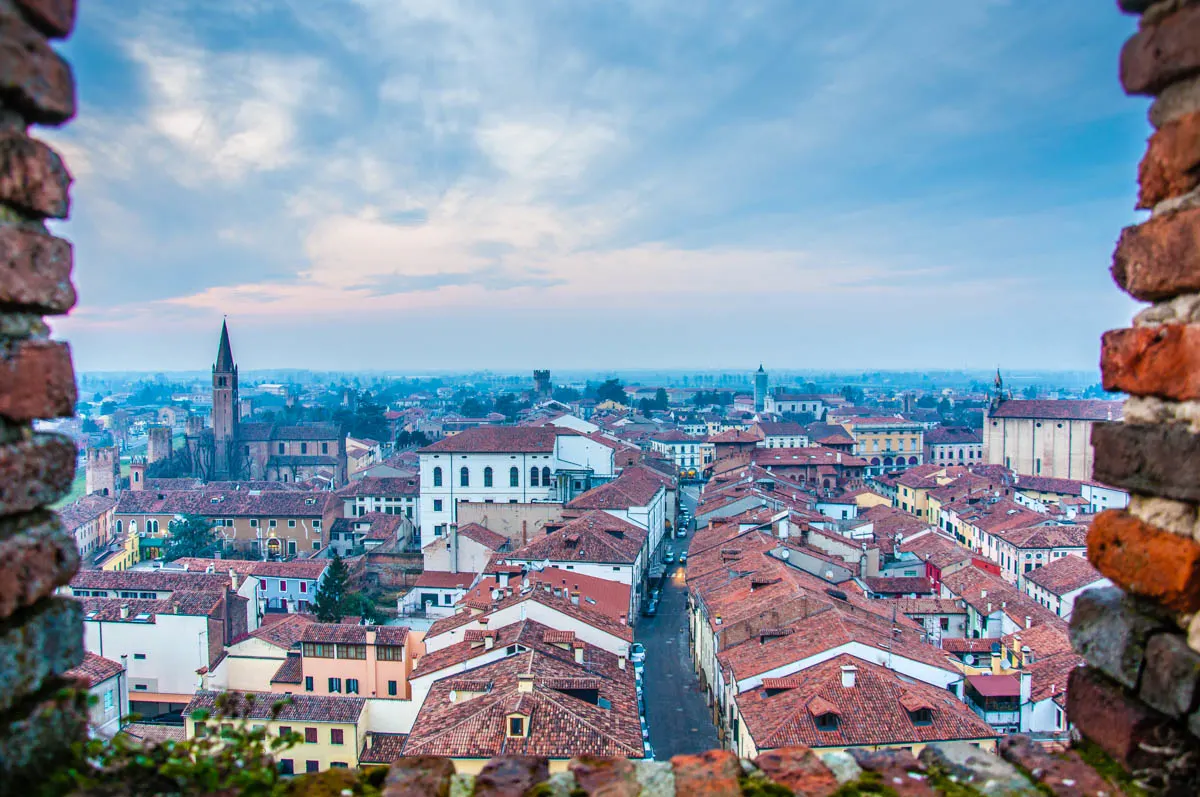
Have a great time in Montagnana, Italy! Here is what to get up to when you come to visit!
Enjoy!
Montagnana, Italy – Top 10 Things to See and Do in the Fortified Town of Prosciutto
1. Medieval Walls
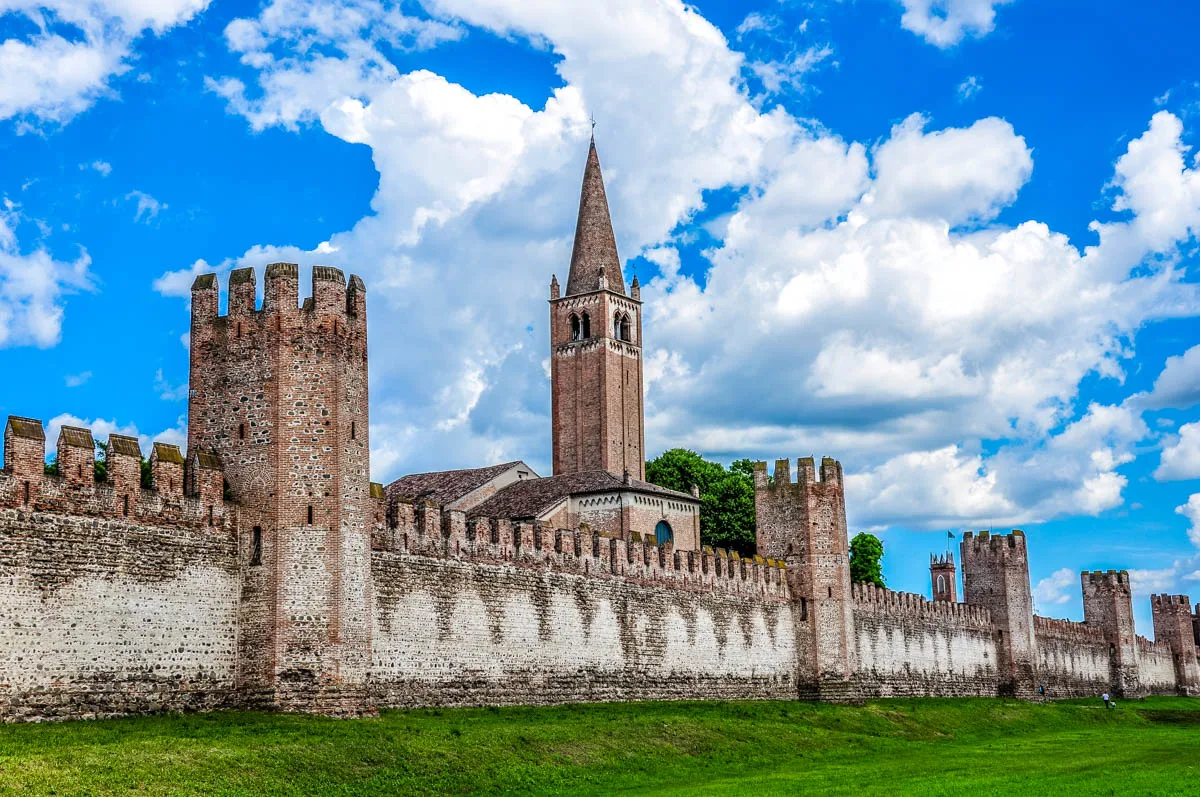
Montagnana proudly possesses a full ring of medieval walls. They are among some of the best-preserved defensive walls in Europe and the world.
Montagnana’s walls follow the rectangular shape of the town’s historic centre and are about one metre thick, six to eight metres high (excluding the battlements) and almost 2 km in length.
Dotted with 24 hexagonal towers reaching 17-19 m in height, Montagnana’s defensive walls have been built and rebuilt over several centuries. They are made of large blocks of trachyte – a grey volcanic rock from the nearby Euganean Hills – and layers of bricks.
The grey and red colours contrast beautifully with the blue skies of the Veneto above and the green grass which nowadays covers what once had been a significant moat around the wall’s base.
The moat was originally between 20 and 40 metres wide, rendering Montagnana incredibly difficult to conquer.
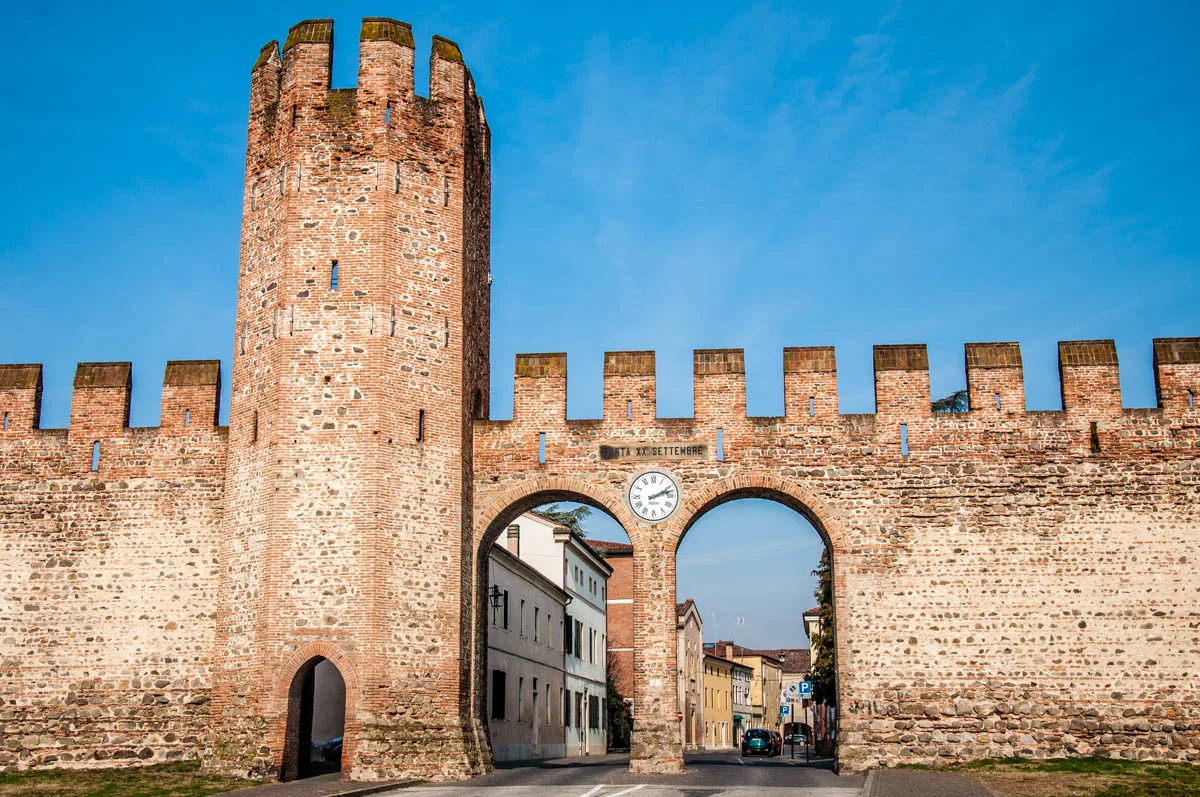
There are four large gates leading in and out of Montagnana’s historic centre: Porta Legnago, Porta XX Settembre, Porta Padova, and Porta Vicenza.
A lovely way to spend a relaxed hour in Montagnana is to go for a walk following the outline of its mighty defensive walls. A gaggle of colourful houses have been built right next to them thus providing a happy contrast to its sober shades of grey and red.
2. San Zeno Castle and Ezzelino’s Tower
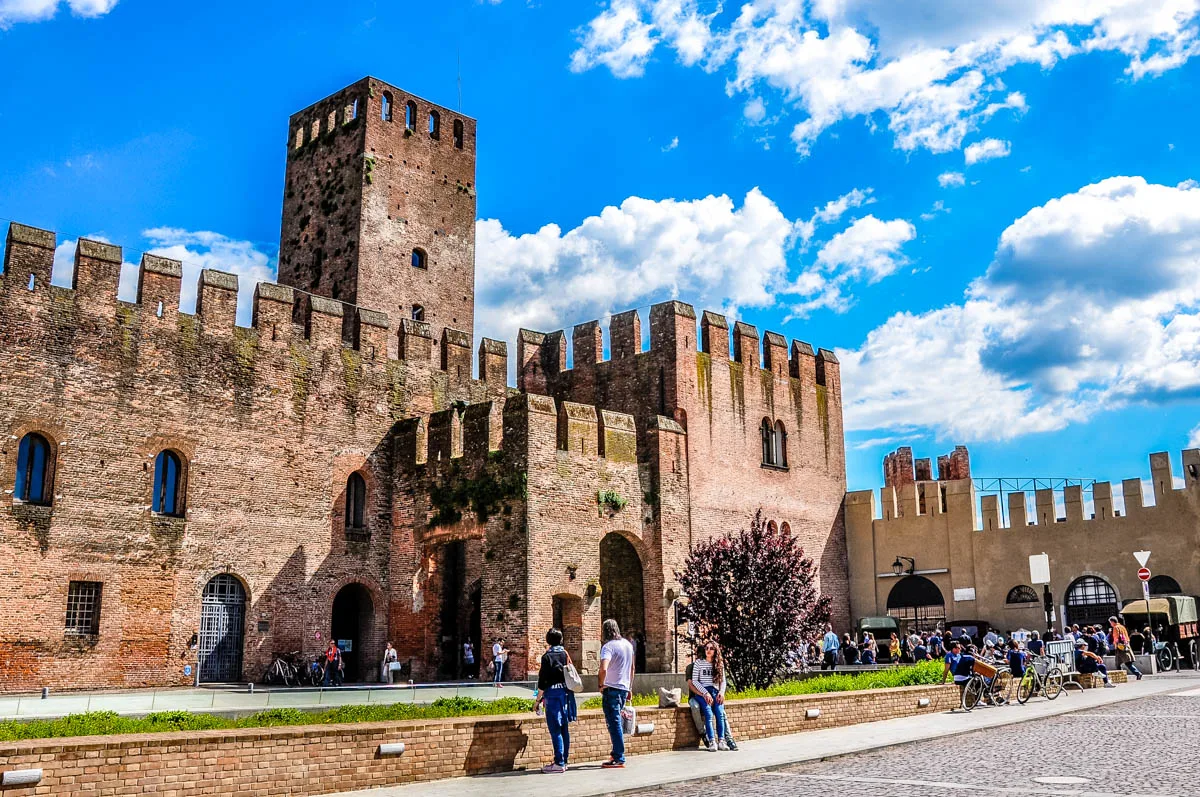
Reaching Porta Padova in the historic centre of Montagnana, you will see a small rectangular castle with a tall tower standing proud right next to it.
San Zeno Castle is the town’s oldest military structure. Through the centuries it has had different roles – from barracks for soldiers to a warehouse for the locally grown hemp (needed for the production of ropes and sails for the boats built at the Venetian Arsenal). Nowadays, the castle houses Montagnana’s Civic Museum.
The museum is very interesting as it allows you to trace the history of Montagnana back to the late Neolithic Age. This is when prehistoric people first settled in the area.
Medieval frescoes and Venetian paintings can also be admired in the museum. In addition, there is a musical section that celebrates two famous tenors from Montagnana – Giovanni Martinelli and Aureliano Pertile.
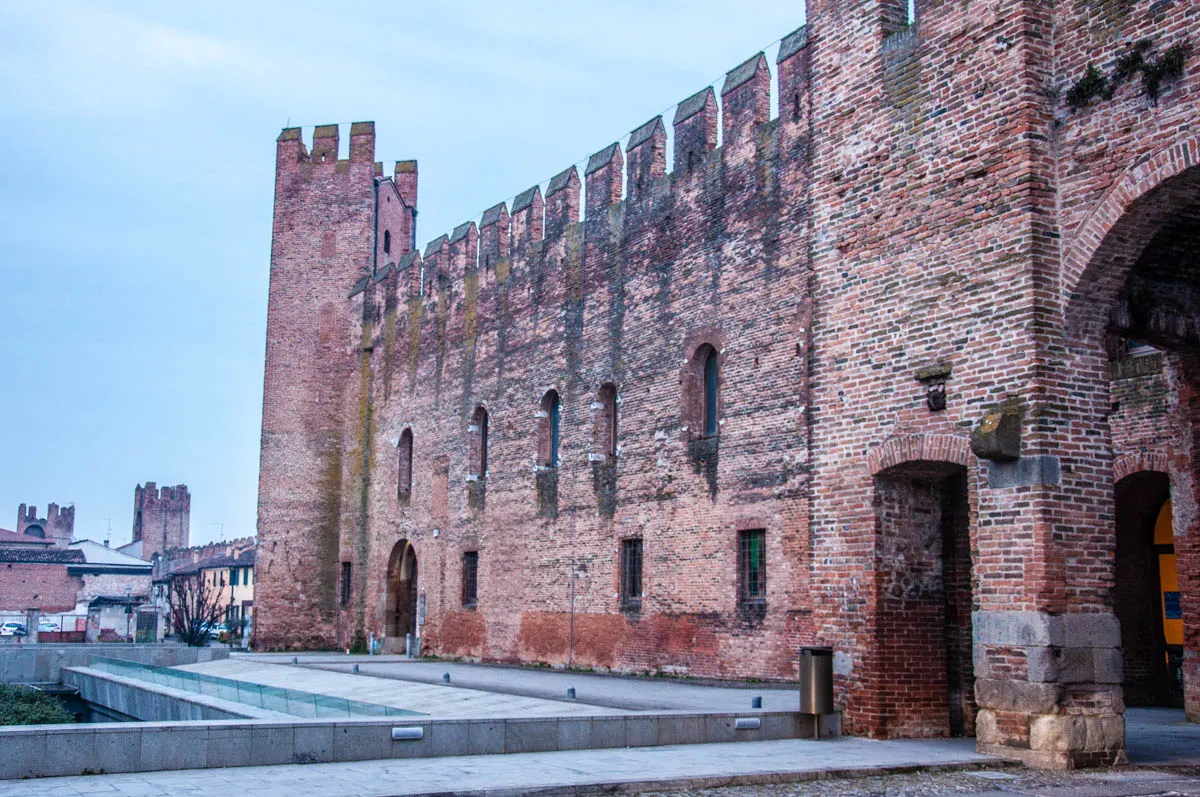
San Zeno Castle also houses the local tourist information office. So, make sure that you stop here first on your exploration of Montagnana in order to pick a map with the main sights, learn curious details about the town, and find out what events may be on when you are here.
Apart from visiting the castle and the Civic Museum inside it, you can also scale the adjacent Ezzelino Tower. 38 metres high, it offers lovely panoramic views over the town of Montagnana, its defensive wall and the surrounding Venetian plains.
Ezzelino III da Romano was an important feudal lord known for his cruelty and tyranny. In 1242 he captured Montagnana. In the same year, he also ordered the construction of the tower which to this day carries his name.
Here is one last curious detail about Montagnana’s San Zeno Castle and the town’s mighty defensive wall: they can be seen in all their glory in a lovely drawing by the famous Venetian painter Giorgione. The drawing – executed in red chalk – nowadays is kept in the Museum Boymans-Van Beuningen in Rotterdam, The Netherlands.
In fact, you can admire Montagnana from the exact point where Giorgione spent some time sketching it. Just outside Porta Padova, there is a small observation place called Piazzola del Giorgione. Standing here you can see Montagnana just like the famous Italian Renaissance painter saw it all those centuries ago.
3. Duomo of Santa Maria Assunta
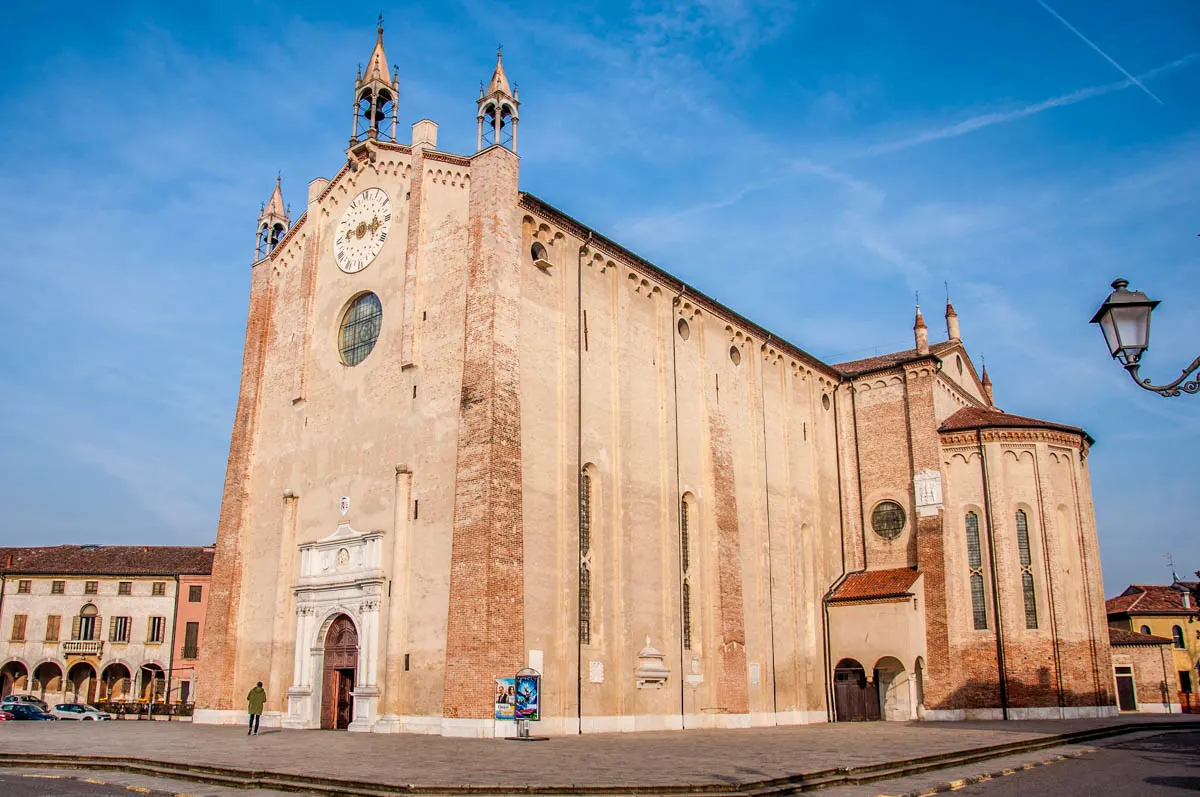
Montagnana’s main church – the Duomo of Santa Maria Assunta – is striking in its shape and height. Built of bricks and with an almost bare facade (save for a dramatic white marble portal and a pretty clockface), it has an imposing body that springs out of the town’s main square and reaches high up towards the sky.
For me, this is one of the most unusual and most memorable churches I have had the chance to see in this part of Italy.
Built between 1431 and 1502 on the site of an 11th-century church of the same name, Montagnana’s Duomo is all about the Late Gothic on the outside and the Renaissance on the inside. Its white marble portal was allegedly designed by Jacopo Sansovino – the Florentine sculptor and architect whose most famous work is the Biblioteca Marciana which stands just across the Doge’s Palace in Venice.
Inside, Montagnana’s Duomo has a rich collection of works of art among which stand out:
- two frescoes by Giorgione – one depicting David at the moment after the defeat of Goliath and the other of Judith who has just beheaded Holofernes;
- the high altar with The Transfiguration of Christ authored in 1554 by Paolo Veronese;
- the astrological frescoes in the Rosary Chapel dating back to the end of the 15th century. They tell the story of a solar eclipse which, it is thought, occurred in Montagnana in 1478;
- an impressive Battle of Lepanto painted at the end of the 16th century by Giulio de Rossi – an artist from the nearby town of Este.
As you can see, the Duomo of Montagnana attracted high-caliber artists and their works are one of the main reasons to visit this beautiful fortified town in the Veneto, Northern Italy.
4. Rocca degli Alberi
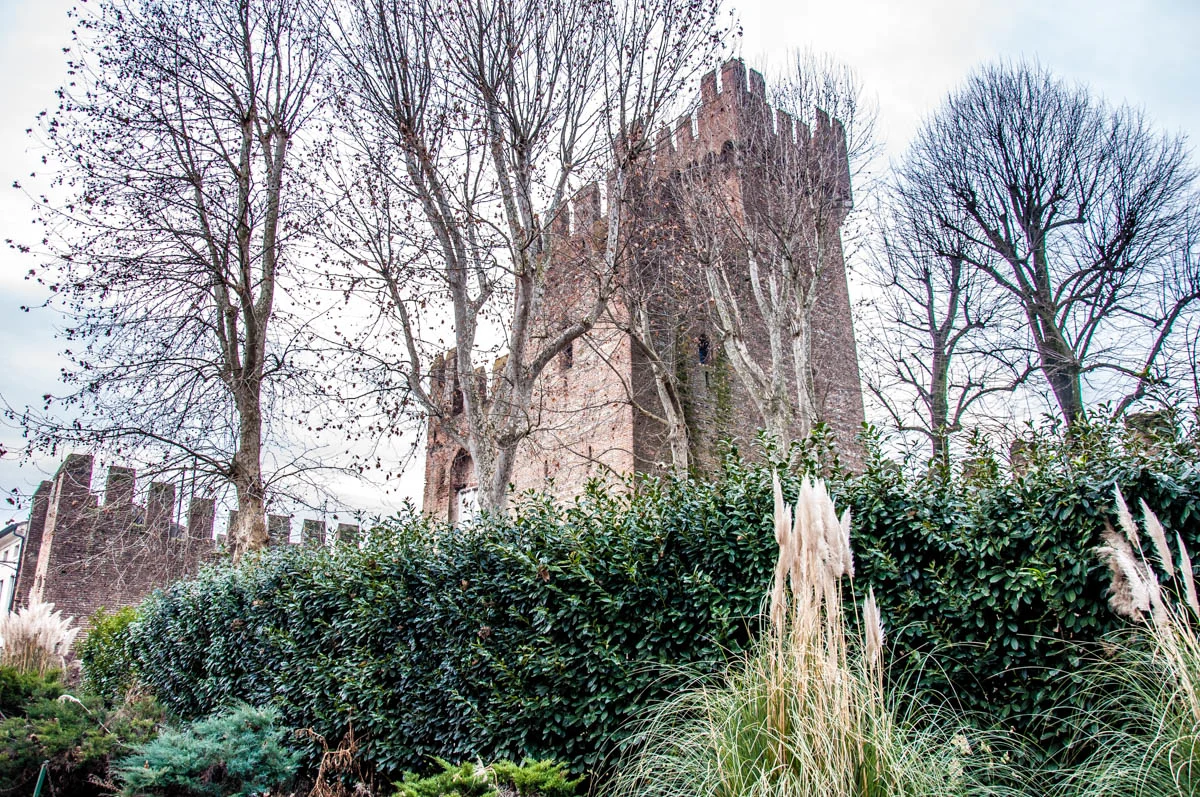
Built between 1360 and 1362, this medieval military stronghold stands at Porta Legnago at the opposite end of Montagnana in relation to San Zeno Castle.
The Rocca was erected on the orders of the Carrara dynasty which at the time ruled over Padua and the adjacent area. The Carrara were an important family in Northern Italy and held an overwhelming power. Often, they were compared to the Visconti of Milan – another powerful family of the medieval age of Italy.
The Rocca degli Alberi was designed as the perfect military fortress and, originally, it was completely surrounded by water on all sides. It could be reached only through a complicated system which included, among other things, several drawbridges and swing doors.
Once Montagnana was annexed to the Republic of Venice in 1405, the Venetians defaced the Carrara family’s coats of arms which had been placed on the Rocca.
5. Prosciutto
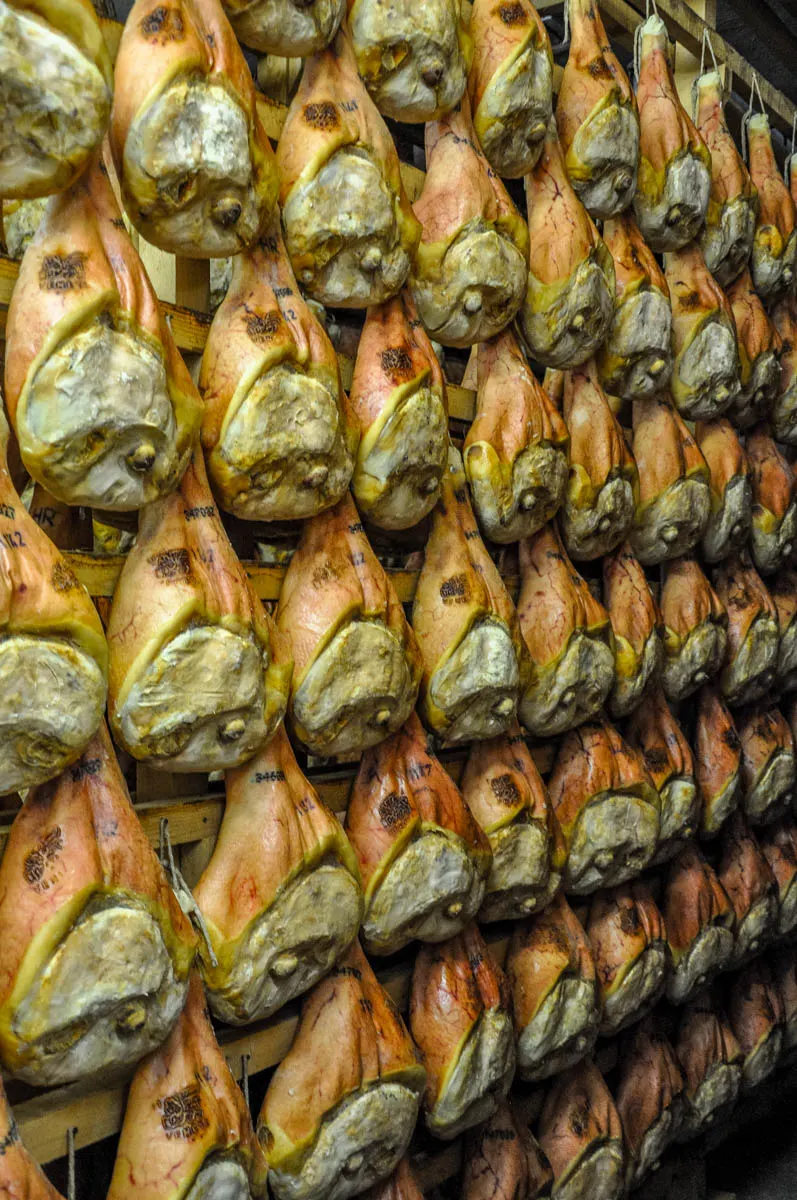
At first glance, it may seem funny to have a food item among a list of things to do and see at a particular destination.
When you delve deeper into it though, you will quickly realise that travelling to Montagnana to sample its prosciutto is just as a valid reason to go there as to see its beautifully preserved medieval walls or to gaze adoringly at the Giorgione’s frescoes and Veronese’s painting in the town’s Duomo.
For Montagnana is a celebrated centre of prosciutto production and just outside of its historic walls, you can find several of the best prosciutto-making factories this side of Italy.
Prosciutto is one of the most strictly controlled food products in the EU. It has to be produced to exacting standards and parameters and it needs to follow centuries-old dry curing techniques.
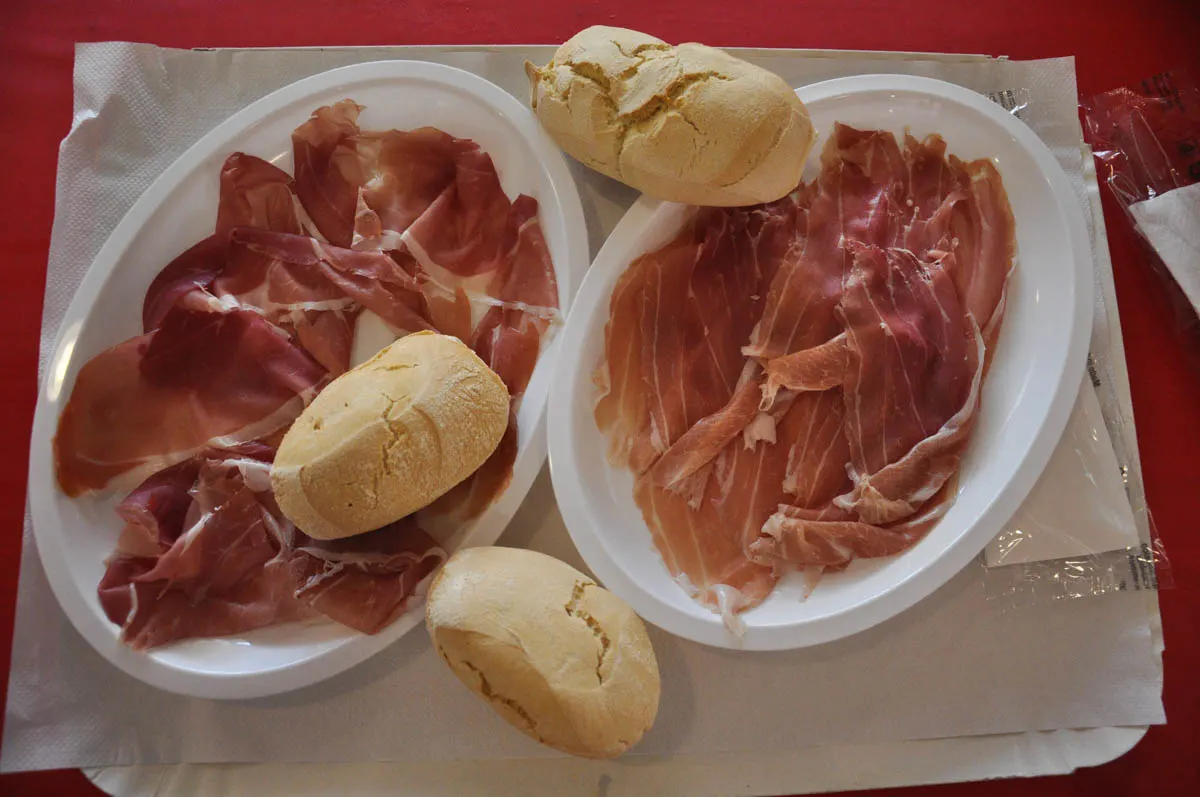
The area around Montagnana, most specifically the 15 parishes between the Berici Hills and the Euganean Hills, is especially suitable for the production of high-quality prosciutto. Known as the Prosciutto Veneto Berico-Euganeo DOP, since 1996 it enjoys a Protected Designation of Origin status and it is famous for its soft texture, pink colour, and sweet taste.
Montagnana takes its prosciutto seriously and every year in May, the town holds a large festival dedicated to it. To learn more about this festival, please click here. To read about how prosciutto is made in Montagnana following centuries-old techniques, please, click here.
6. Montagnana’s Main Square
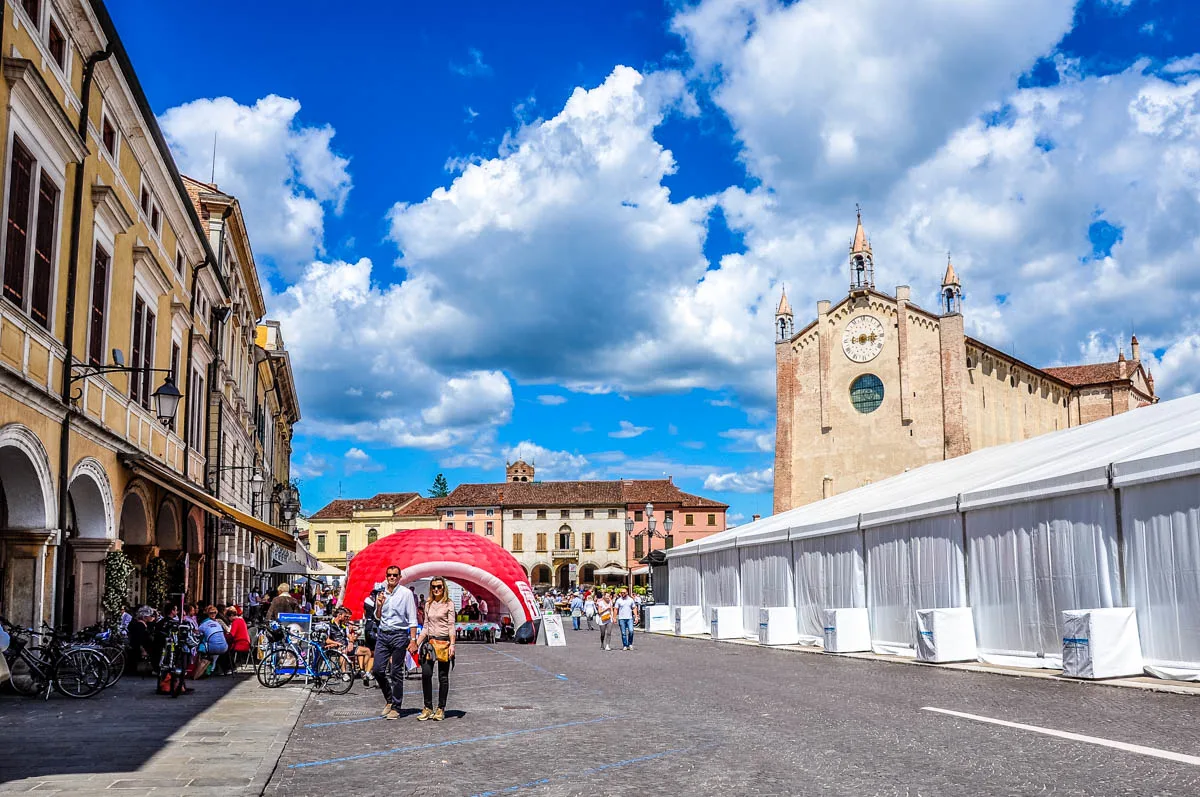
Life in Italy is centred around the square. Called piazza in Italian, squares here are the stage where daily life takes place. From weekly markets to large celebrations, the Italian piazza is at the heart of the community.
Montagnana’s main square – Piazza Vittorio Emanuele II – is particularly impressive. Surrounded by gorgeous houses and palaces, its huge expanse is dominated by the proud outline of the Duomo of Santa Maria Assunta (see point 3 above).
It is at this piazza that Montagnana’s yearly prosciutto festival takes place, with a large marquee set up in the middle of the square to serve perfect slices of the best prosciutti to the discerning locals.
It is great being here, in the middle of this historic town, on a feast day. This is when the square is full of people and vibrates with energy. On regular days, the square seems to gets taken over by lines of neatly parked cars which is a bit of a shame. Yet what to do when you have to adapt a medieval town to our modern lives?!
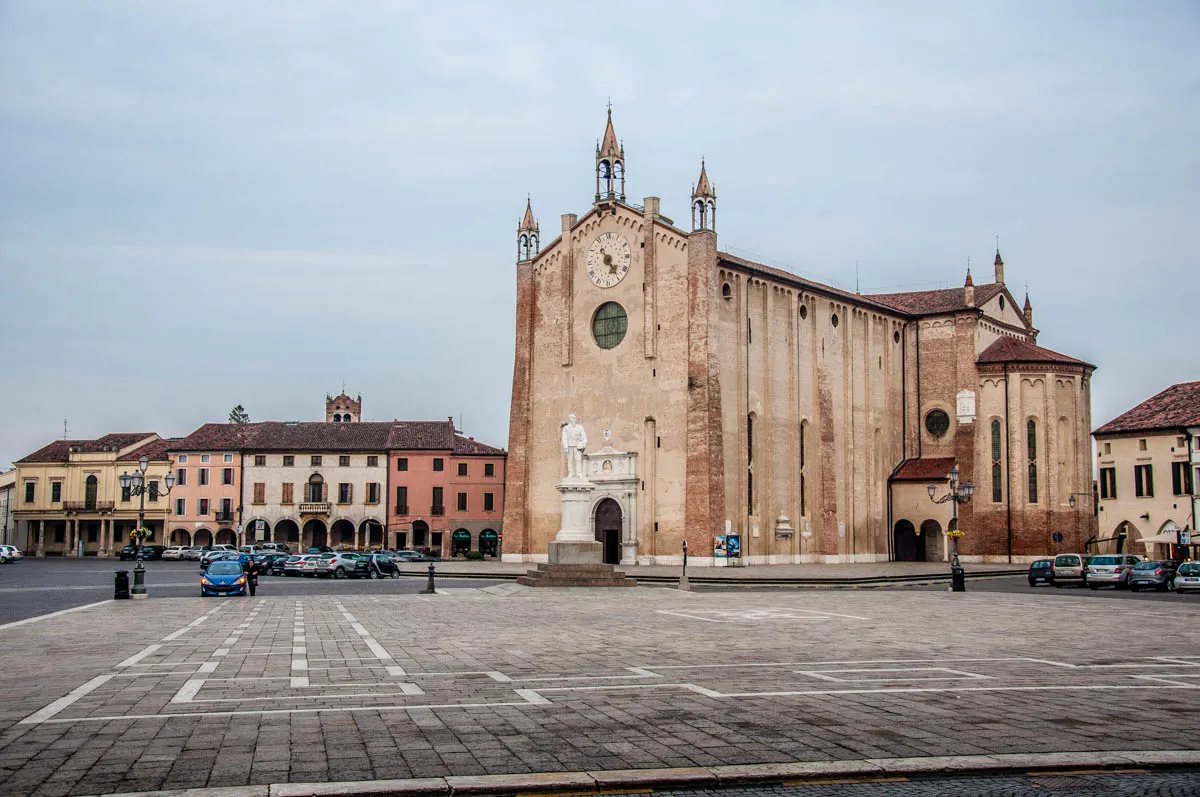
One curious thing about Montagnana’s main square is that it evokes St. Mark’s Square in Venice. Covered with blocks of grey trachyte – a volcanic rock from the nearby Euganean Hills – look closer and you will spot decorative outlines made of white stone just in the fashion of the square’s Venetian Big Brother.
7. Montagnana’s Palaces
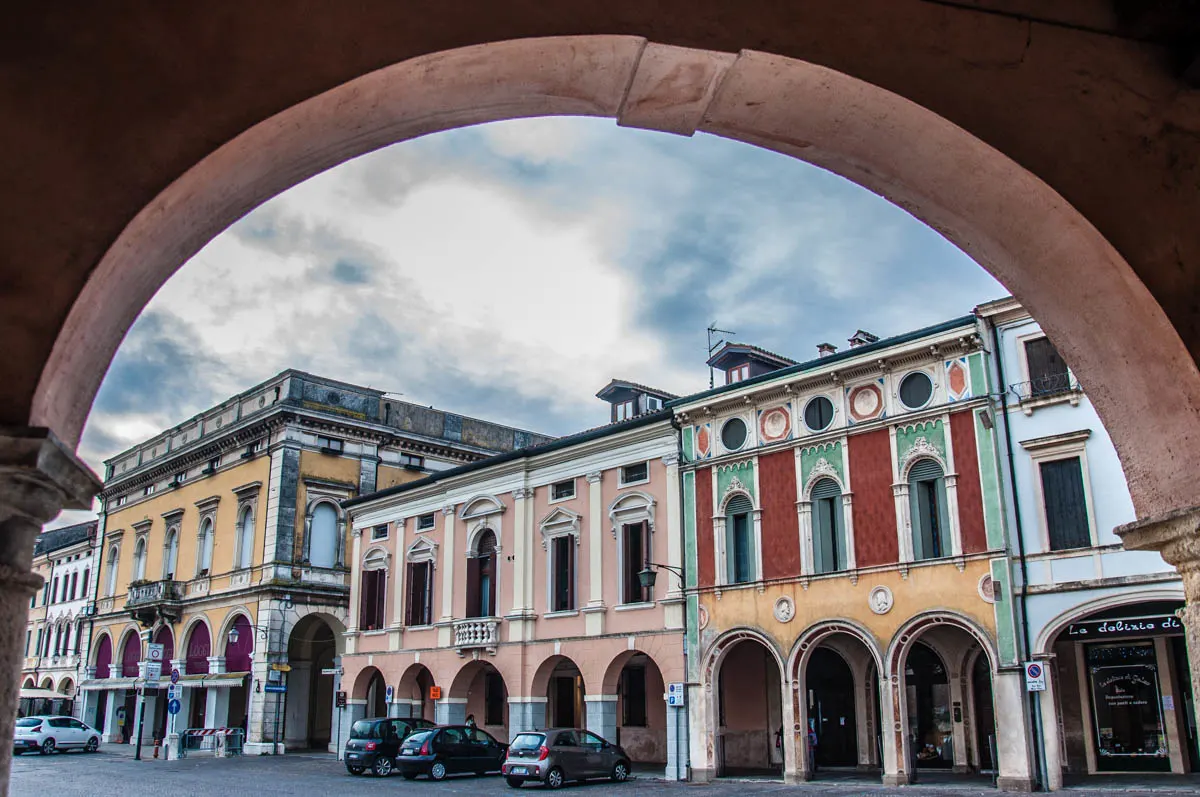
The historical centre of Montagnana is dotted with elegant palaces which are a pleasure to look at as you walk around town.
Embellished facades, Venetian windows, stone medallions, whimsical chimneys, stone portals, long porticoes sheltering the passers-by both from the hot summer sun and the cold winter rains…
There are many details to catch your eye and make you catch your breath as you explore this little jewel of a town with medieval walls and Gothic and Renaissance palaces. I particularly like the beautiful chimneys of Palazzo Zanella and the 15th-century palace of Monte di Pieta.
Still, among the many stunning buildings that you can see here, the 15th-century Palazzo Magnavin-Foratti deserves a special mention. It is thought that this elegant building was designed by Pietro Lombardo. He was the architect and main sculptor of one of the most delightful churches in Venice – the pretty as a picture Church of Santa Maria dei Miracoli.
More interestingly though, it is alleged that Palazzo Magnavin-Foratti in Montagnana used to be the residence of one Giacoma di Antonio da Leonessa. Giacoma (also referred to as Jacopa) was the wife of the great condottiero Erasmo da Narni. He is mostly known under his nickname – Gattamelata (Honeyed Cat) – as he was very shrewd and had a very diplomatic way with words.
The condottieri were highly valued men during Italy’s Renaissance. Military captains, they had at their command regimens of mercenaries which the Italian princes and dukes would contract to use in the incessant wars between themselves.
Gattamelata was one of the most famous and ferocious condottieri of his time. For his service to the Republic of Venice, he was awarded many properties and land in the area of Montagnana.
After Gattamelata’s death, his widow commissioned the renowned Florentine artist Donatello to cast a full-size bronze statue of her husband on a horse. Donatello spent ten years working on the sculpture and, once completed, it was positioned in front of the Basilica of St. Anthony in Padua where it can be still seen today.
It’s important to note that Donatello’s statue of Gattamelata on a horse was the first full-size equestrian monument to be successfully cast since Antiquity.
8. Montagnana’s Churches

Although small in size, the historical centre of Montagnana is dotted with several churches that are worth a visit. Here are some of them:
- Nativity Church & Hospital – a small oratory next to an old convent which served as a hospital for the poor since the beginnings of the 15th century. The top floor of the church was covered in frescoes which nowadays are preserved at the Gallerie dell’Accademia in Venice.
- Church of San Francesco – an ancient church first documented in 1350 but most probably standing at this place from even earlier back in time. Spend a bit of time in it to admire its 14th-century frescoes, its 18th-century organ, and a canvas by the Venetian painter Palma il Giovane.
- Church of San Benedetto – a deconsecrated Late Baroque church that currently is used as an exhibition and concert space.
- Church of San Antonio Abate – a 12th-century oratory with many architectural and decorative elements confirming the presence of the Templars in Montagnana.
9. Villa Pisani (Also Known as Villa Pisani Placco) and the Borgo Veneziano
Designed in the mid-16th century by Andrea Palladio – one of the most influential architects in the Western World – Villa Pisani is one of Montagnana’s jewels. You can spot it just outside of the town’s defensive walls, opposite Porta Padova and San Zeno Castle.
The villa is only rarely open for visits and it looks a bit sad sitting so close to the traffic that trundles around Montagnana. However, it gives you a good idea of what the Palladian style stands for.
If your visit to Montagnana is your only foray into the Veneto’s countryside, then stop for a few minutes to take in this villa and to admire its facade which evokes a classical temple. Otherwise and if you have the chance, make sure that you visit some of Palladio’s better-known villas which are more regularly opened to the public – like Villa Capra la Rotonda on the outskirts of Vicenza – in order to get the full Palladian experience.
What makes Montagnana’s Villa Pisani remarkable though is that, unlike many of the villas designed by Palladio, it has a second floor. Thus, Villa Pisani is a hybrid between a town palazzo and a rural Palladian villa.
Its original owner – the powerful Venetian nobleman Francesco Pisani – was a patron of the arts and commissioned a stable of renowned artists like Veronese. A large painting by the famous painter from Verona used to hang in Villa Pisani in Montagnana. Called The Family of Darius Before Alexander nowadays it’s owned by the National Gallery in London, England.
The Borgo Veneziano (or the Venetian Hamlet in English) is a small cluster of villas and palaces just further down from Villa Pisani. These luxury residences were built by Venetian noblemen with commercial and agricultural interests in Montagnana.
10. Montagnana’s Events
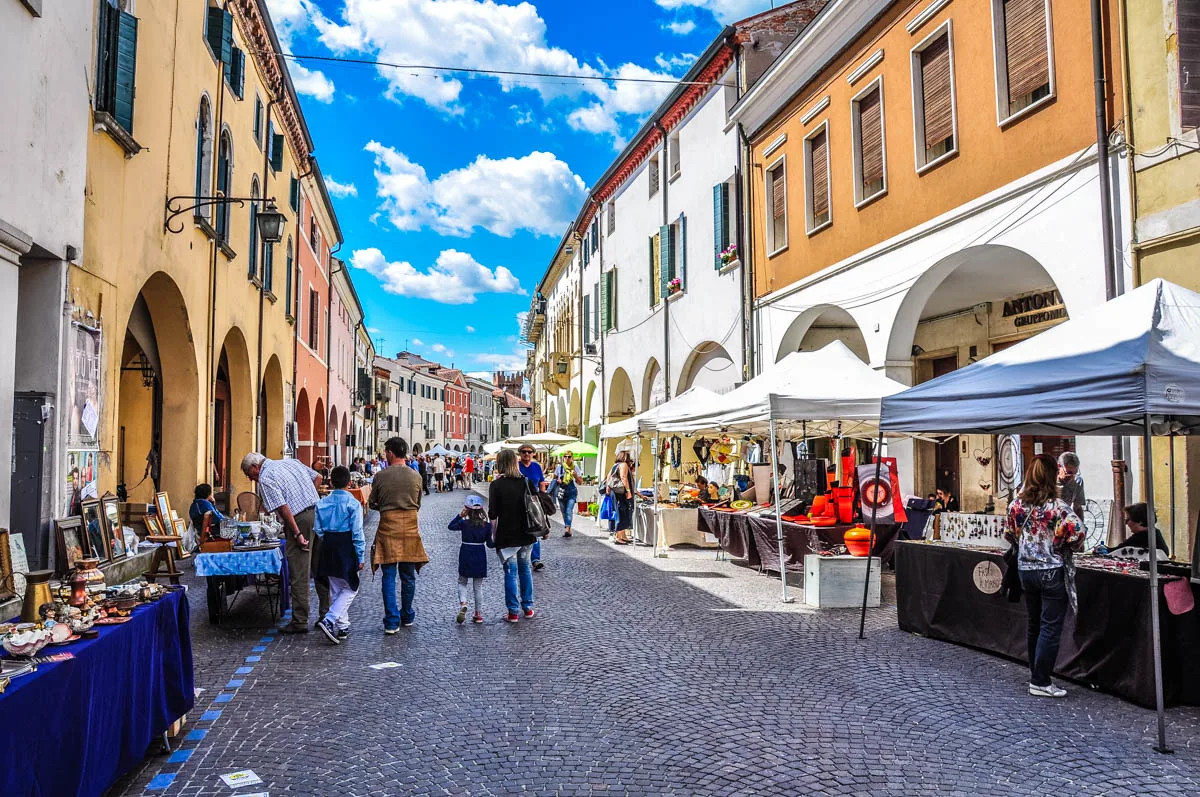
Exuberant and authentic, the events held in Montagnana are a great way to delve into the traditions of this corner of Italy.
If you can, make sure that your visit to this beautiful town coincides with one of the many festivals that take place here year-round. Here is a shortlist with the most popular of them so as to make your planning easier. Where possible, I have also included a link to the official website of the event. In case there is no English version of the website you are interested in, you can use Google Translate to get the gist of the information:
- Festival of St. Anthony the Abbot – celebrated on 17th January;
- Spring Fair – with a large market dedicated to flower-growing. It’s held either in March or April;
- Prosciutto Festival – one of the most important events in the local calendar. It’s held over ten to twelve days in May;
- Fly Party – an air show and an aircraft exhibition. In fact, Montagnana has a very active air club which organises different flight courses and aviation events;
- Om de Mer – a triathlon where each participant has to wear a moustache. It’s held in August;
- Palio 10 Comuni – a large historical reenactment bringing together Montagnana’s ten municipalities. It’s held in September.
In addition to the above, there are many other events and festivals held in Montagnana throughout the year. From weekly markets every Thursday to monthly antiques and collectibles markets, there is always something happening here.
In a Nutshell, What Is the history of Montagnana, Italy?
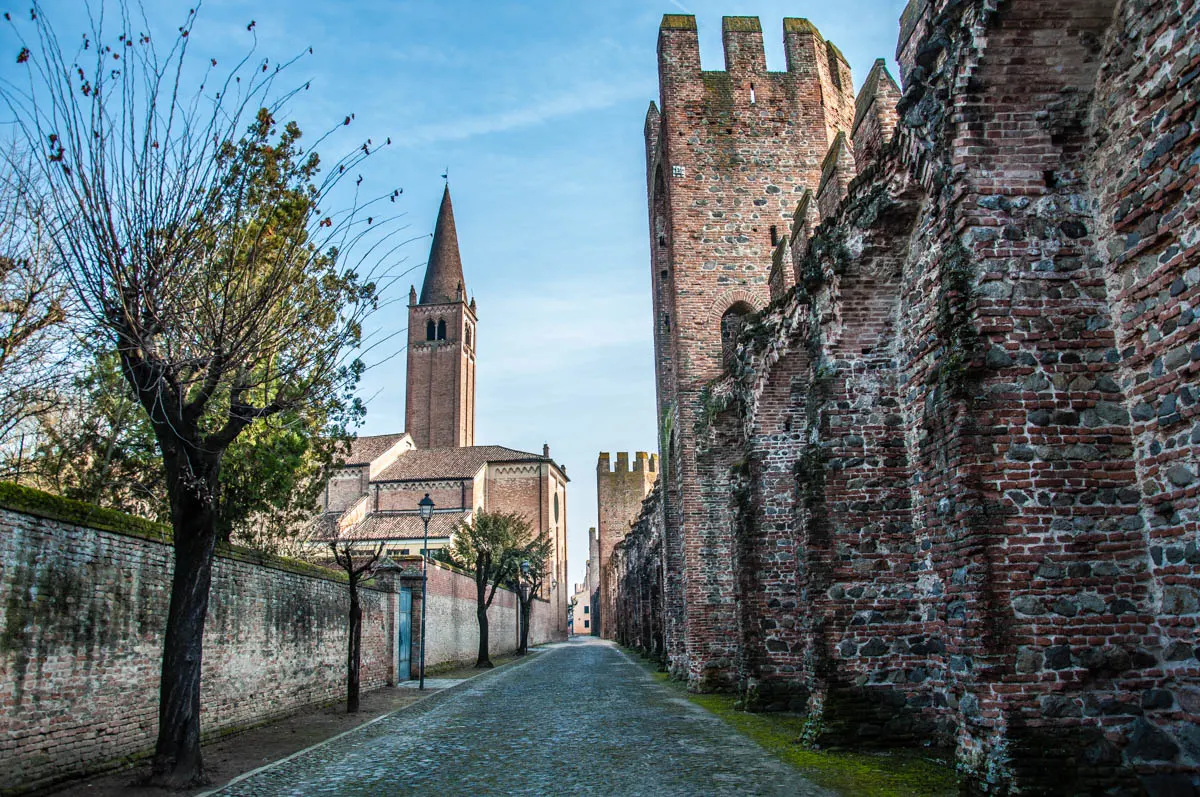
Although nowadays Montagnana is thought of, predominantly, as a medieval walled town dotted with Gothic and Renaissance treasures, the area where it stands has been a centre of human activity for many millennia.
In fact, on your visit to Montagnana’s Civic Museum in San Zeno Castle (see point 2 above), you will see locally excavated archaeological artifacts dating back to the Late Neolithic Age.
The Romans also made Montagnana their home and the town had a strategic position on Via Emilia Altinate – a Roman road that connected the delta of the river Po with Padua.
It’s interesting to note that Montagnana’s name comes from the Medieval Latin toponym Motta Aeniana, where:
- motta meant a small hill – allegedly the teeny-tiny hill on which San Zeno Castle was built, otherwise, Montagnana is erected on a completely flat ground; and
- aeniana referred to a mansio that existed there at the time. A mansio was a post house or in other words, an official stopping place on a Roman road for the use of officials and couriers while travelling. This is where they could change horses and equipment or deliver mail to other couriers to take forward.
During the Middle Ages, the area of Montagnana suffered from the incursions of the Hungarians and a castle was built to withstand their ferocious attacks. The town started forming around the castle and by the 12th century it was ruled over by the Marquis of Este.
In the 13th century, Montagnana was caught in the Guelphs vs Ghibellines struggle for power. The Guelphs supported the Pope and the Ghibellines – the Holy Roman Emperor.
The powerful feudal lord Ezzelino III da Romano – a Ghibelline himself – set Montagnana on fire in 1242 and then set on rebuilding the conquered town. The 38-metre tall tower next to San Zeno Castle was built on the orders of Ezzelino and to this day it bears his name.
Towards the end of the 13th century, Montagnana became part of the lands of the Carrara family. They were a powerful medieval dynasty and Lords of Padua.
The Carara rebuilt and reinforced Montagnana’s defensive wall. In 1362 they also completed the Rocca degli Alberi – a military fortress on the opposite end of Montagnana in relation to San Zeno Castle.
In 1405, Montagnana surrendered to the Republic of Venice and for centuries attracted Venetian noblemen who built lavish palaces in and around the town and commissioned celebrated architects and artists to design and decorate them. The town was of special interest to Venice as it provided the hemp needed for the manufacture of sails and ropes used on the thousands of Venetian boats that were built at the time.
With the fall of Venice in 1797 to Napoleon, Montagnana was ruled first by the French and then by the Austrians until it joined Italy in July 1866.
Nowadays, this small fortified town in the Venetian plains attracts visitors with its beautifully preserved medieval walls and gorgeous Late Gothic and Renaissance buildings and works of art. Visiting Montagnana is like opening a door directly to the past and experiencing it on a day to remember forever.
Practical Tips and Information About Visiting Montagnana, Italy
1. Where is Montagnana, Italy?
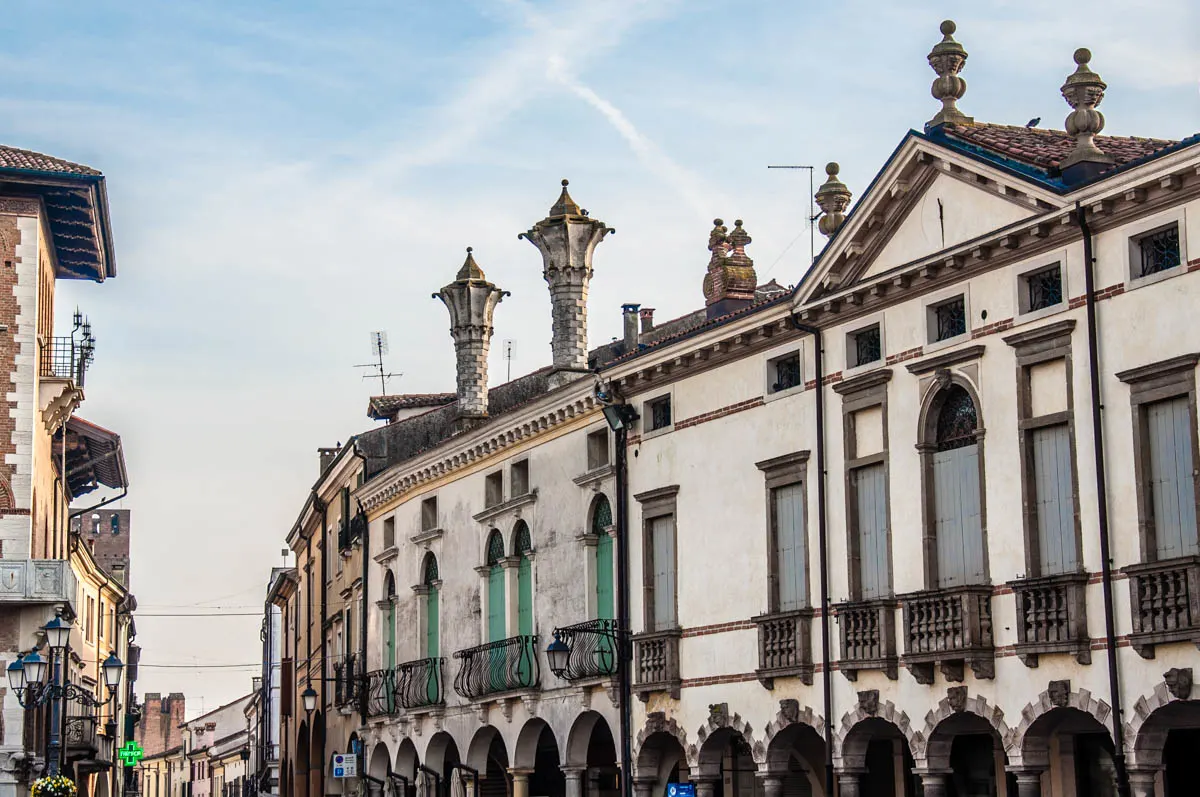
You will find Montagnana in the Northern Italian region of the Veneto.
Nestled in the Venetian plains, this charming fortified town is almost equidistant from three of the Veneto’s main cities – Vicenza, Verona, and Padua. This makes Montagnana a great destination for a day trip.
You can explore Montagnana on its own or combine it with a visit to the nearby Euganean Hills or another fortified town in the vicinity like Este and/or Monselice.
2. How to Reach Montagnana, Italy?
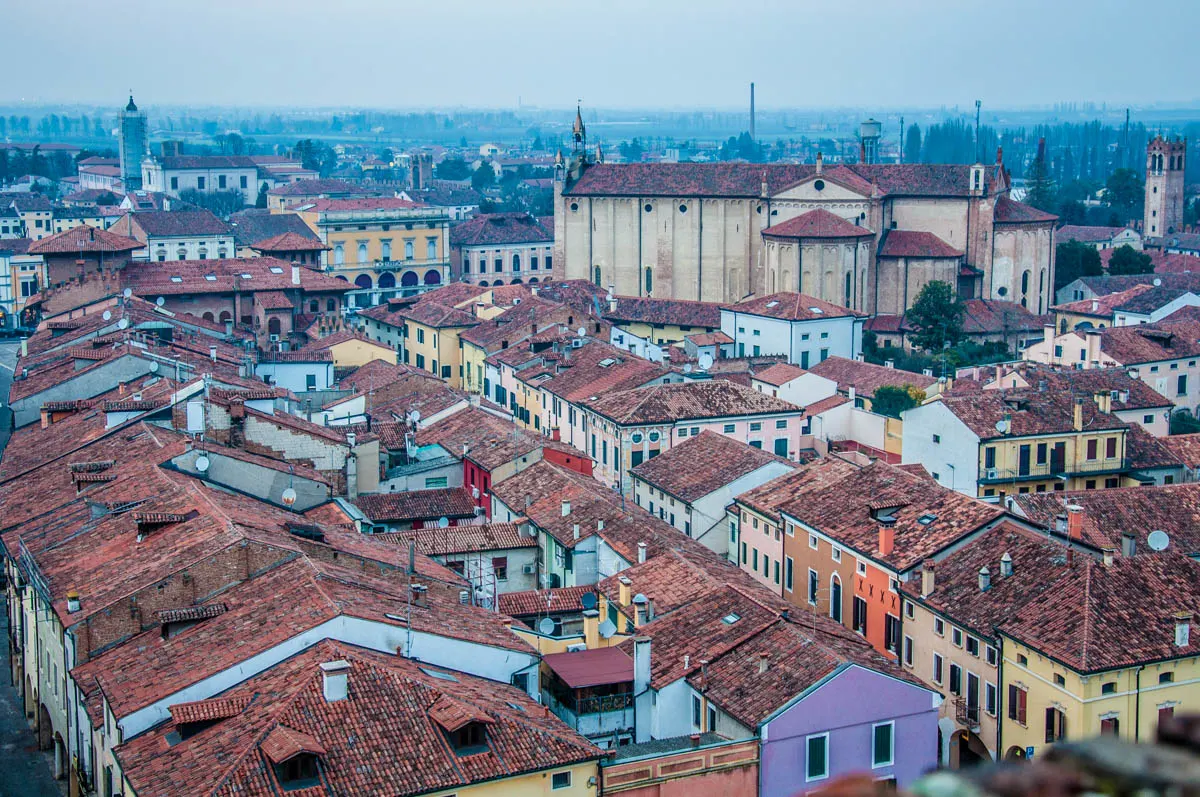
You can easily reach Montagnana by car from anywhere in the Northern Italian region of the Veneto and especially from three of its main cities – Vicenza, Verona, and Padua.
In addition, you can take a train from Padua to Montagnana (you will need to change at Monselice) or a bus from Vicenza.
For up to date travel information, please, use one of these three websites:
- Google Maps – for GPS instructions and public transport itineraries;
- Rome2Rio – to research all transport options to Montagnana – by car, public transport, and taxi;
- TrenItalia – for train tickets and timetables.
3. What to know before visiting Montagnana, Italy?

Montagnana is a fairly small town and as such shops and sights may close for riposo – Italy’s traditional afternoon break which may last anything from two to four hours. To avoid having to wait around for things to re-open in the afternoon, please:
- familiarise yourself with the cultural background of riposo and how to make the most of it;
- check in advance the opening hours of any sights and places you would like to visit in Montagnana. The town’s official website – Visit Montagnana – is a good starting point.
Then, plan accordingly.
4. What else to see and visit around Montagnana, Italy?
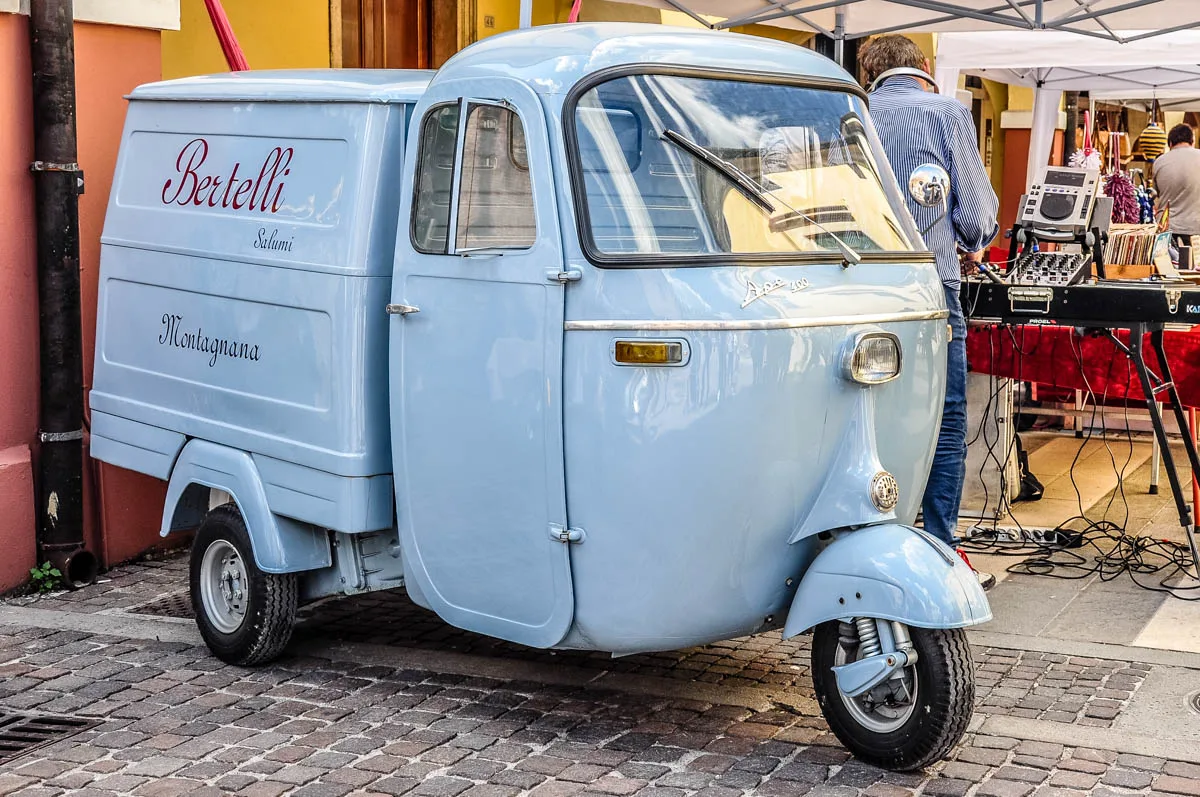
Montagnana is close to three of Veneto’s main cities – Vicenza, Verona, and Padua – as well as to a myriad of fortified towns, areas of natural beauty, and lavish Venetian villas.
As such, you can plan your time so that a visit to Montagnana is combined with a stop at one or several of the following places:
- Cities – Vicenza, Verona, Padua;
- Fortified towns and villages – Este, Monselice, Arqua Petrarca.
- Venetian Villas – Villa Pojana, Villa Correr.
- Nature – Euganean Hills, Berici Hills,
The choice is yours!
In Conclusion
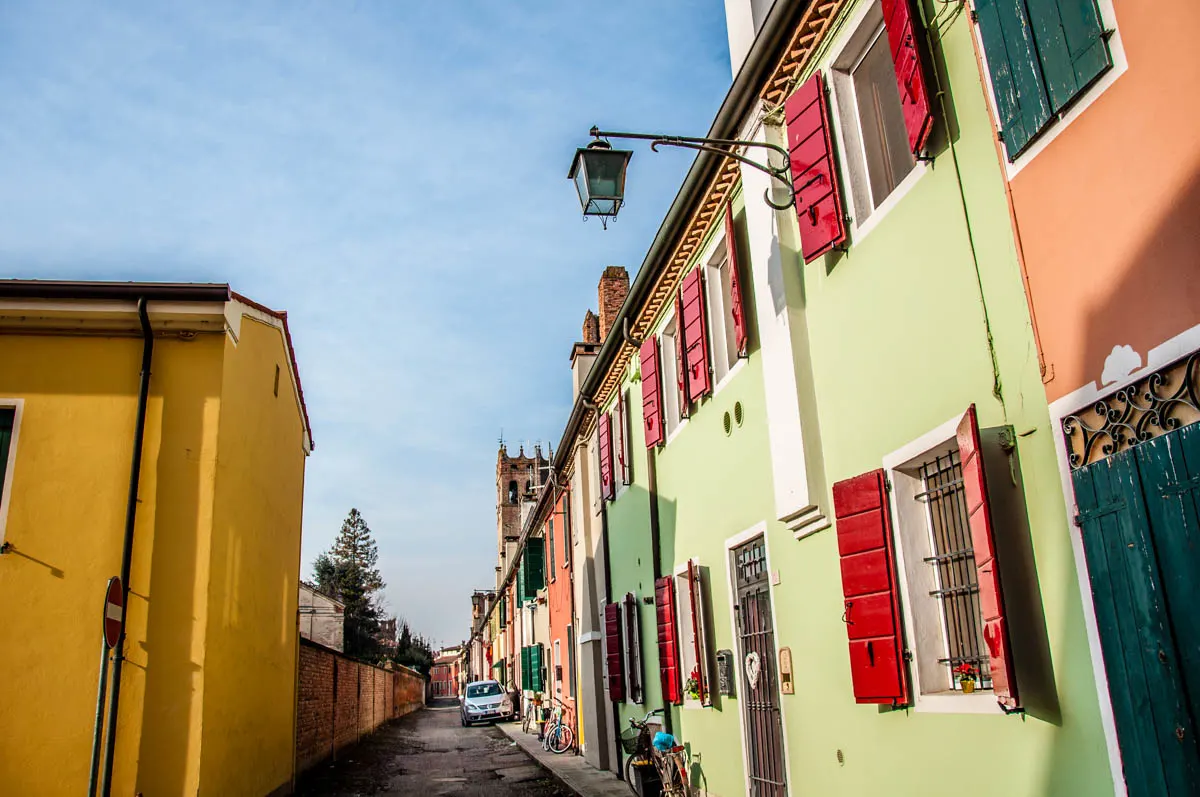
Montagnana is a beautiful fortified town in the plains of the Northern Italian region of the Veneto.
At an approximately equal distance from three of Veneto’s most important cities – Vicenza, Verona, and Padua – Montagnana is a great destination for a day trip, especially if you love history and have an eye for beauty.
Surrounded by a massive defensive wall, visiting Montagnana is like stepping back into the Middle Ages. The town served as a battleground for several powerful medieval dynasties which vied over its strategic position and arable land. Once the Republic of Venice annexed Montagnana in 1405, the town took on a Venetian appearance. Through the centuries, it attracted a stable of famous painters, architects, and sculptors whose works of art can still be admired there today.
Montagnana is also famous for the locally produced prosciutto. Enjoying a Protected Designation of Origin status, the Prosciutto Veneto Berico-Euganeo DOP is the town’s proudest export and it is celebrated by the locals with a long festival each May.
In addition to it, Montagnana has a rich program of events taking place all through the year.
Visiting this small yet exciting town is to see the best that the Veneto has to offer – from history and art to good food and great entertainment. Montagnana is a must-see on a day trip to the Venetian countryside.
The above blog post gives you a nice and tidy list with the main things to see and do in Montagnana. It also provides you with a quick overview of the town’s history and offers some practical tips to make your visit as smooth and enjoyable as possible.
I hope that you will put Montagnana on your must-see list and that you will have a wonderful time there!
For further information about Montagnana, please, also have a look at these two blog posts of mine:
More Helpful Links for Day Trips in Italy
- Day Trips from Padua – 35 Unmissable Destinations in the Veneto, Lombardy, and Emilia-Romagna
- Day Trips from Verona – 16 Destinations to Fall in Love With (With Travel Times and Train Tips)
- Day Trips from Vicenza, Italy – Over 90 of the Best Destinations
- 11 of the Best Day Trips from Venice (With Lots of Photos, Travel Times and Italy Train Tips)
- Best 12 Towns to Visit Around Lago di Garda – Italy’s Largest Lake
- 18 of the Best Cities to Visit in Northern Italy (With Travel Tips and Nearest Airports)
- Este, Italy – Top 9 Things to Do in This 3000-Year-Old Walled Town
- Campo di Brenzone – A Great Day Trip to a Medieval Village in the Hills Above Lake Garda, Italy
- Sanctuary of Madonna della Corona – Visiting Italy’s Church Suspended Between Heaven and Earth
- Montecchio Maggiore, Italy – 4 Hidden Gems You Need to See in the Real Town of Romeo and Juliet
- Grotte di Caglieron – Caves, Waterfalls and Cheese – A Great Day Trip in the Veneto, Northern Italy
- Lago di Fimon – A Pleasant Lakeside Walk Just Outside Vicenza, Italy
- Villa Pisani, Italy – A Detailed Guide to the Queen of the Venetian Villas
- Pieve di Cadore’, Italy – 6 Things to Do in Titian’s Birthplace
- 3 Butterfly Houses (And One Insect Museum You Need to Visit in Italy)
- Trentino, Italy – Castles, Hikes, and Alpacas – The Perfect 4-Day Itinerary
Do you like exploring walled towns in Italy or anywhere else in the world? Which one was your favourite one? Let me know in the Comments section below.
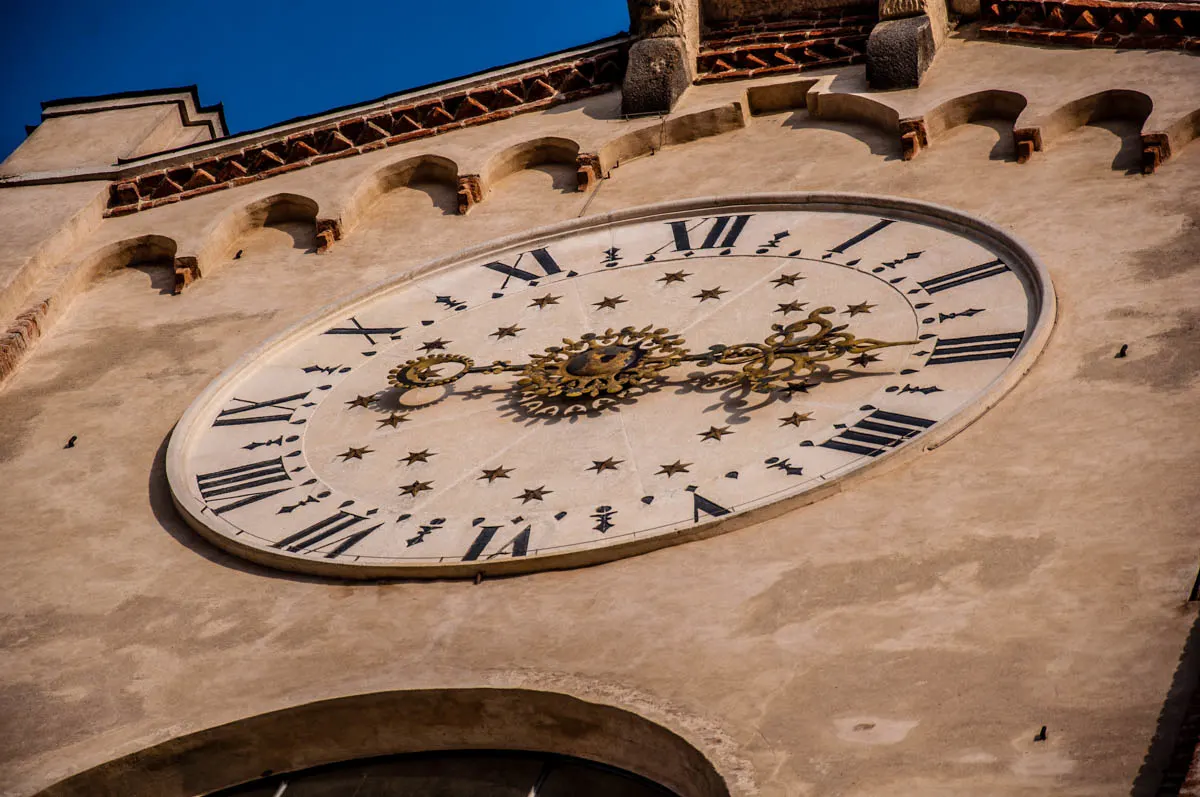
Thank you for reading! Please, leave me a comment, pin the image below or use the buttons right at the top and at the end of this blog post to share it on social media.
For more useful information like this, please, like my blog’s page on Facebook and subscribe to my strictly no-spam newsletter.
